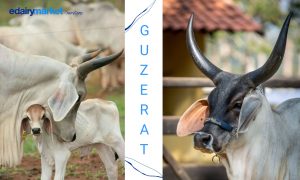
Despite considerable research, nothing definitive is known about the actual origin of the cattle first brought to the island of Jersey. Most research agrees that the Jersey probably originated on the adjacent coast of France, where Jersey-like cattle are found in Normandy and Brittany. So before we get started with the count, let’s tell you about the origin of Jersey cows.

Whatever the correct phylogenetic form of the Jersey might be, it would appear, when analysing the available data, that the domesticated fore-father of the Jersey came from Asia, belonged in all probability to Bos brachyceros, was probably tamed during the Stone Age, some 10 000 years ago or more and migrated to Europe through Central and Southern Europe and North Africa to Switzerland and France. In Northern France some cross-breeding undoubtedly took place between the pure Bos brachyceros and Bos primigenius herds (which mostly came down the North Coast of Europe to as far down as Northern France).
Jersey Island being joined to France until about A.D. 709 by a narrow isthmus, it stands to reason that cattle from Normandy and Brittany were brought over regularly in the early days to Jersey Island and must have played a very important role in the origin and development of the present day Jersey.
Jerseys are known to exist in the UK mainland since 1741 and probably well before. At that time they were known as Alderneys.
The flourishing times for the breed was the period from the 1860s to the First World War when the Jersey cow enjoyed the greatest period of development for the breed worldwide. For many years, thousands of animals were shipped to the USA annually, but records show that early settlers took Jerseys there in 1657. Canada imported her first Jerseys in 1868. Jerseys first went to South Africa in 1880, and in 1862 New Zealand imported her first cattle.
Although records of earlier importations into Australia are not available, it is believed that the first Jerseys arrived as “ship cows.” The first reference of a Jersey dates back to 1829 when Mr. J. T. Palmer of Sydney advertised the sale of 200 pure bred Jerseys.
Latin America imported its first Jerseys before the turn of the century. Records show that around 1892, the first cattle went to Guatemala. Brazil had its first Jerseys four years later. But it was probably Costa Rica that first imported the breed to Central and South America in 1873.
Today, the Jersey breed is the second largest breed of dairy cattle in the world. On Jersey itself there are fewer than 6000 Jerseys in total with nearly 4000 of these being adult milking cows. The purity of the breed on the island is maintained by a strict ban on imports. This ban has been in place for some 150 years. There are no other breeds of the cattle on the island.
Jerseys are well known for their milk which is noted for its high quality – it is particularly rich in protein, minerals and trace elements. It is also rich in colour which is naturally produced from carotene, an extract from grasses. The Jerseys has an ability to adapt to many kinds of climates, environments and management practices.
It is typically light brown in colour, though this can range from being almost grey to dull black, which is known as Mulberry. They can also have white patches which may cover much of the animal. A true Jersey will however always have a black nose bordered by an almost white muzzle.
The Jersey hard black feet are much less prone to lameness. The Jersey is relatively small in size – about 400 to 450kgs in weight and have a fine but strong frame.
With all this information, eDairy Market presents 9 key characteristics of Jersey cows:
1. Jerseys produce a pound of milk components at a lower cost compared to the other major breeds.
2. Has few or no calving problems, higher fertility, shorter calving interval and earlier maturity.
3. Jerseys stay in the herd longer than any other dairy breed.
4. Jersey milk has higher nutritional value, in addition to higher yields and greater efficiency when processed into cheese and other value-added products.
5. Jersey milk commands a premium price in many markets.
6. Jerseys perform well in a wide range of systems and are well known for their high feed conversion efficiency.
7. Jersey milk is unique in many ways. As a product it contains: – 18% more protein, 20% more calcium, 25% more butterfat than “average” milk.
8. Jerseys are well known for being less susceptible to lameness due to their black color which makes their hooves very hard. Because Jerseys are a lighter breed, this may also cause less lameness problems.
9. Good temperament is important in a dairy cow. In today’s modern parlors, fast performance is a top priority. An animal that misbehaves by continually kicking units will cause unwanted delays and even damage expensive equipment. Jerseys are believed to have one of the best temperaments among dairy breeds, although much of this depends on the management the animals receive.
Did you know any of these facts?
✅ At eDairy Market we have all the dairy categories, all the products and all the companies. We represent you.
✅ Power your business through eDairy Market:
- Your microsite with products, brand and domain of your company at a minimum cost.
- You will be able to sell your products and we do not charge you commission per sale.
- Now you can sell your Products, Ingredients and Dairy Machinery in English, Spanish, Portuguese and Mandarin Chinese.
✅ Create your own online store in a super easy way:
























